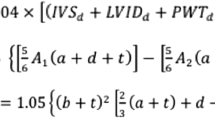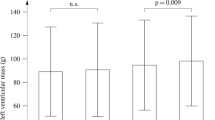Abstract
Background
Cardiac MRI is an accurate and reproducible technique for the assessment of left ventricular volumes and function. The accuracy of automated segmentation and the effects of manual adjustments have not been determined in children.
Objective
To evaluate automated segmentation and the effects of manual adjustments for left ventricular parameter quantification in pediatric cardiac MR images.
Materials and methods
Left ventricular parameters were evaluated in 45 children with suspected myocarditis (age 13.4 ± 3.5 years, range 4–17 years) who underwent cardiac MRI. Dedicated software was used to automatically segment and adjust the parameters. Results of end-diastolic volume, end-systolic volume, stroke volume, myocardial mass, and ejection fraction were documented before and after apex/base adjustment and after apex/base/myocardial contour adjustment.
Results
The software successfully detected the left ventricle in 42 of 45 (93.3%) children; failures occurred in the smallest and youngest children. Of those 42 children, automatically segmented end-diastolic volume (EDV) was 151 ± 47 ml, and after apex/base adjustment it was 146 ± 45 ml, after apex/base/myocardial contour adjustment 146 ± 45 ml. The corresponding results for end-systolic volume (ESV) were 66 ± 32 ml, 63 ± 29 ml and 64 ± 28 ml; for stroke volume (SV) they were 85 ± 25 ml, 83 ± 23 ml and 83 ± 23 ml; for ejection fracture (EF) they were 57 ± 10%, 58 ± 9% and 58 ± 9%, and for myocardial mass (MM) they were 104 ± 31 g, 95 ± 31 g and 94 ± 30 g. Statistically significant differences were found when comparing the EDV/ESV/MM results, the EF results after apex/base adjustment and after apex/base/myocardial contour adjustment and the SV results (except for comparing the SVs after apex/base adjustment and after apex/base/myocardial contour adjustment).
Conclusion
Automated segmentation for the evaluation of left ventricular parameters in pediatric MR images proved to be feasible. Automated segmentation + apex/base adjustment provided clinically acceptable parameters for the majority of cases.


Similar content being viewed by others
References
Debatin JF, Nadel SN, Paolini JF et al (1992) Cardiac ejection fraction: phantom study comparing cine MR imaging, radionuclide blood pool imaging, and ventriculography. J Magn Reson Imaging 2:135–142
Bellenger NG, Burgess MI, Ray SG et al (2000) Comparison of left ventricular ejection fraction and volumes in heart failure by echocardiography, radionuclide ventriculography and cardiovascular magnetic resonance: are they interchangeable? Eur Heart J 21:1387–1396
Van der Geest RJ, Buller VG, Jansen E et al (1997) Comparison between manual and semiautomated analysis of left ventricular volume parameters from short-axis MR images. J Comput Assist Tomogr 21:756–765
Waiter GD, McKiddie FI, Redpath TW et al (1999) Determination of normal regional left ventricular function from cine-MR images using a semi-automated edge detection method. Magn Reson Imaging 17:99–107
Lalande A, Legrand L, Walker PM et al (1999) Automatic detection of left ventricular contours from cardiac cine magnetic resonance imaging using fuzzy logic. Invest Radiol 34:211–217
Young AA, Cowan BR, Thrupp SF et al (2000) Left ventricular mass and volume: fast calculation with guide-point modeling on MR images. Radiology 216:597–602
Van der Geest RJ, Lelieveldt BP, Angelié E et al (2004) Evaluation of a new method for automated detection of left ventricular boundaries in time series of magnetic resonance images using an active appearance motion model. J Cardiovasc Magn Reson 6:609–617
Uzümcü M, van der Geest RJ, Sonka M et al (2005) Multiview active appearance models for simultaneous segmentation of cardiac 2- and 4-chamber long-axis magnetic resonance images. Invest Radiol 40:195–203
Lynch M, Ghita O, Whelan PF (2006) Left-ventricle myocardium segmentation using a coupled level-set with a priori knowledge. Comput Med Imaging Graph 30:255–262
Pednekar A, Kurkure U, Muthupillai R et al (2006) Automated left ventricular segmentation in cardiac MRI. IEEE Trans Biomed Eng 53:1425–1428
Angelié E, Oost ER, Hendriksen D et al (2007) Automated contour detection in cardiac MRI using active appearance models: the effect of the composition of the training set. Invest Radiol 42:697–703
Beyar R, Shapiro EP, Graves WL et al (1990) Quantification and validation of left ventricular wall thickening by a three-dimensional volume element magnetic resonance imaging approach. Circulation 81:297–307
Petitjean C, Dacher JN (2011) A review of segmentation methods in short axis cardiac MR images. Med Image Anal 15:169–184
Brodoefel H, Tsiflikas I, Kramer U et al (2012) Accuracy of automated attenuation-based 3-dimensional segmentation: in the analysis of left ventricular function compared with magnetic resonance imaging. Tex Heart Inst J 39:36–43
Hautvast GL, Salton CJ, Chuang ML et al (2012) Accurate computer-aided quantification of left ventricular parameters: experience in 1,555 cardiac magnetic resonance studies from the Framingham Heart Study. Magn Reson Med 67:1478–1486
Lu YL, Connelly KA, Dick AJ et al (2013) Automatic functional analysis of left ventricle in cardiac cine MRI. Quant Imaging Med Surg 3:200–209
Cocosco CA, Niessen WJ, Netsch T et al (2008) Automatic image-driven segmentation of the ventricles in cardiac cine MRI. J Magn Reson Imaging 28:366–374
Liu H, Hu H, Xu X et al (2012) Automatic left ventricle segmentation in cardiac MRI using topological stable-state thresholding and region restricted dynamic programming. Acad Radiol 19:723–731
Barbier CE, Johansson L, Lind L et al (2007) The exactness of left ventricular segmentation in cine magnetic resonance imaging and its impact on systolic function values. Acta Radiol 48:285–291
Mosteller RD (1987) Simplified calculation of body-surface area. N Engl J Med 317:1098
Nassenstein K, de Greiff A, Hunold P (2009) MR evaluation of left ventricular volumes and function: threshold-based 3D segmentation versus short-axis planimetry. Invest Radiol 44:635–640
Jaspers K, Freling HG, van Wijk K et al (2013) Improving the reproducibility of MR-derived left ventricular volume and function measurements with a semi-automatic threshold-based segmentation algorithm. Int J Cardiovasc Imaging 29:617–623
Conflicts of interest
None
Author information
Authors and Affiliations
Corresponding author
Rights and permissions
About this article
Cite this article
Hammon, M., Janka, R., Dankerl, P. et al. Pediatric cardiac MRI: automated left-ventricular volumes and function analysis and effects of manual adjustments. Pediatr Radiol 45, 651–657 (2015). https://doi.org/10.1007/s00247-014-3219-2
Received:
Revised:
Accepted:
Published:
Issue Date:
DOI: https://doi.org/10.1007/s00247-014-3219-2




